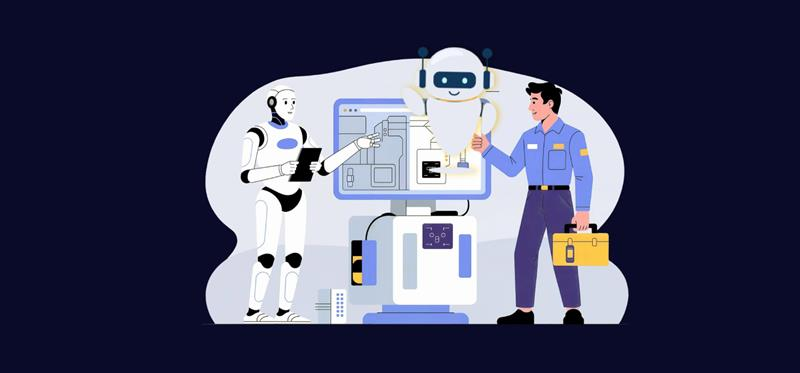From Pilot to Plant-Wide Automation with RPA In Manufacturing Industry
Robotic Process Automation is transitioning from small, isolated use cases to full-scale adoption across factories. What began as a set of limited pilots has now grown into a strategic effort to strengthen efficiency, accuracy, and responsiveness. As manufacturers refine their digital operations, RPA in manufacturing is becoming a central element of plant-wide automation.
How Do Manufacturers Move from Pilot Projects to Scalable RPA Programs?
Most manufacturers start with small pilots focused on repetitive, rules-based tasks. These pilots help teams understand workflows, identify potential challenges, and measure value. However, reaching a plant-wide automation vision requires more than isolated experiments.
To scale operations, teams usually follow a clear progression:
- Mapping cross-functional processes instead of department-specific tasks
- Creating RPA governance to manage development, updates, and training
- Integrating RPA with existing systems such as MES, ERP, and quality management platforms
- Setting standards for documentation, version control, and exception handling
This approach shifts RPA from a test environment to a structured automation framework that supports long-term growth.
What Makes Plant-Wide Automation Different from Basic RPA Deployment?
Basic deployment focuses on automating individual tasks such as data entry, reporting, or scheduling. Plant-wide automation, however, connects multiple workflows into unified digital sequences. The goal is to help machines, operators, and systems exchange information without delay or manual intervention.
Key Differences
- Wider automation scope that covers procurement, production, maintenance, supply chain, and quality
- Stronger data flow between systems to reduce information gaps
- Real-time decision support that guides teams faster
- Automated compliance checks and documentation
In this expanded environment, RPA trends in manufacturing show a shift toward deeper collaboration between software bots and production technologies.
Which Areas of the Factory Benefit the Most from Expanded RPA Adoption?
Around 87% of routine tasks in factories can be automated using RPA technologies. (Strategic Market Research, 2023)
RPA can support nearly every stage of a manufacturing cycle, but some areas experience rapid improvements when automation is scaled.
Common Benefiting Areas
- Production planning: Automated scheduling, capacity checks, and order updates
- Quality assurance: Inspection data collection, issue logging, and traceability reports
- Maintenance operations: Work order creation, parts tracking, and equipment history updates
- Inventory management: Stock reconciliation, reorder alerts, and supplier communication
- Supply chain workflows: Shipment coordination, invoice matching, and delivery confirmations
As manufacturers broaden their use of RPA, they achieve a more streamlined environment where errors decrease and throughput increases.

How Do RPA Manufacturing Trends USA Influence Global Adoption?
Manufacturers in the USA are focusing on transforming entire production chains rather than automating isolated tasks. This approach is inspiring global adoption, as companies seek consistent quality, faster response, and greater resilience.
RPA Manufacturing Trends Highlights
- Greater focus on integrating RPA with industrial IoT platforms
- Broader use of RPA for sustainability reporting and energy tracking
- Growth in automation for supplier coordination and fulfillment
- Stronger investment in digital skills within the workforce
Countries around the world are taking cues from these trends to modernize factories and create standardized automation practices.
What Role Does AI-Enhanced RPA Play in Plant-Wide Automation?
AI-supported RPA enables factories to automate tasks that involve judgment, classification, and pattern recognition. This moves automation beyond simple rule-based processes to include decision-oriented scenarios.
AI-enhanced RPA supports:
- Document analysis for quality and compliance
- Predictive maintenance workflows based on equipment patterns
- Production insights generated from sensor data
- Automated responses to common exceptions
As RPA trends in manufacturing evolve, the combination of RPA and AI is helping factories build more adaptive and intelligent plant-wide systems.
Powered by AI and ML integration, RPA is deployed by 43% of manufacturers, with another 43% planning new projects. (Market.us Scoop, 2025)
How Should Manufacturers Prepare Their Workforce for Expanded RPA Usage?
Scaling RPA in manufacturing industry operations changes daily workflows for teams, so preparation is essential. Rather than replacing human skills, automation shifts employees toward oversight, coordination, and problem-solving.
Manufacturers usually prepare their teams through:
- Clear communication about upcoming changes
- Training programs to help employees design, test, and monitor bots
- Upskilling for data interpretation and system management
- Collaborative work environments where humans and software bots operate together
By building digital confidence among employees, manufacturers create stronger foundations for long-term automation success.
How Does RPA Contribute to a More Connected and Transparent Factory?
Plant-wide automation enhances visibility across the factory floor. With automated data capture, reporting, and system updates, teams gain reliable information for planning and decision-making.
A simple table below shows how RPA strengthens transparency:
| Area | Traditional Approach | RPA Enabled Approach |
| Data capture | Manual entry | Automated updates |
| Process tracking | Disconnected systems | Centralized, real time flow |
| Quality checks | Delayed reporting | Faster detection and documentation |
| Inventory insights | Periodic review | Continuous visibility |
Conclusion
RPA in manufacturing is moving beyond trial-level experiments and shaping full-scale automation strategies. As factories embrace plant-wide automation, they gain clearer workflows, stronger data flow, and rapid operational response. With thoughtful planning, workforce preparation, and AI-assisted capabilities, RPA environments are becoming more agile and connected. From pilot to plant-wide transformation, the journey reflects a shift toward smarter and more integrated manufacturing operations.
FAQs
How long does it take to expand an RPA pilot into full plant-wide automation?
Timelines vary, but most manufacturers progress in stages that align with system readiness, process complexity, and workforce training.
Can RPA integrate with existing manufacturing software?
Yes, RPA integrates with platforms such as MES, ERP, CRM, and quality management systems without major structural changes.
Is plant-wide automation expensive to maintain?
Maintenance costs depend on the number of bots, update frequency, and support structure, but many manufacturers optimize these through centralized governance.
What skills do employees need to work with RPA?
Employees benefit from skills in process mapping, digital coordination, testing, and monitoring automation workflows.
Does RPA support sustainability goals in manufacturing?
Yes, automated tracking, documentation, and resource management can help factories improve energy monitoring and waste reduction.

 contact
contact

 By
By 


